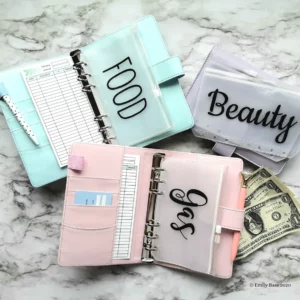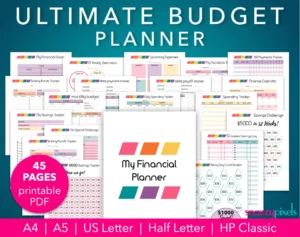Currently in 2022, Americans are spending almost 35% of their income on housing, with the next biggest expense being private transportation, and the third highest expense being food for the average household, reports The Ascent.
No matter what your income is, these are important factors to consider when budgeting. How can you keep expenses under control if you don’t know where your money is going?
Your car loan might be pushing you over your monthly expenses so perhaps it would be wise to trade it in for a different car with a smaller loan or no loan.
Perhaps groceries are costing you more with inflation and bursting your budget. Find a coupon app or rewards programs that will cut down on the bill.
Whatever the reason your finances are tight, having a budget can help you see where you’re overspending and from there you can make a plan.
There are countless ways to organize finances because there are many ways that people get paid and pay bills. Personal budgeting methods can look very different from household to household.
So how do you know the best budgeting methods for you?
With many types of budgeting methods, you’ll have to decide which one is right for your situation in order to gain control of your finances and start hitting those important goals.
What are the Approaches to Budgeting?
From the time you get your first paycheck, it is important to know how to handle your income for financial success. Setting and sticking to a budget is the key to properly managing your money.
Not a single household has the same exact income and expenses as the next household which explains the different ways of budgeting.
Every individual should approach budgeting with the mindset of saving and accomplishing financial goals. There are several factors to budgeting that the individual needs to consider.
Incoming Funds
This is the most important factor of the entire budget approach. Calculate all money you have coming into all accounts on a regular basis. This final number will determine how much you have to spend.
When you are deciding on a regular basis try using a weekly, bi-weekly, or monthly approach.
You really don’t want to go longer than monthly because most bills are scheduled on a 30-day cycle and it is easiest to organize within that time frame.
Outgoing Money
To calculate your outgoing money, you’ll need all bills from your previous three months.
This is the most accurate way to handle outgoing money because some bills are paid quarterly such as some trash removal services, water bills, and non escrowed taxes.
Once you’ve added the total of these set bills, you’ll subtract it from your income. For quarterly bills, you’ll divide them into three and set aside that one-third amount each month.
In addition to set bills, there are items on your ‘outgoing money’ list that need to be set. Things like groceries should be given a maximum amount each period, usually every week.
If you set your grocery amount to be no more than $100 per week, make sure you set aside that amount from your paycheck.
If you get paid every two weeks, you’d set aside $200 from that paycheck to cover the two weeks of groceries between paychecks.
In addition, you’ll want to have a section of miscellaneous expenses for example: clothing allowances, entertainment funds, and household needs.
In an overview of previous months, you can get a glance at what you typically spend in these areas and if it is too much or too little, adjust accordingly.
Once you’ve established an approach to budgeting, starting with the two factors above, you can determine what your financial goals for budgeting should be.
There might be tweaking that needs to be done in certain areas and you can decide what luxuries can be cut out of your budget to make room for savings when you have a good overview of incoming and outgoing funds.
Consider Reading: Monthly Budget Planner Worksheet – Why You Need to Start Budgeting Today
What Are Examples of Budget Methods?
There is always a method that works best for your particular situation. For budgeting, there are several strategies to consider.
Some individuals may have a goal of saving $25,000 for a down payment on a house. Another individual might be drowning in debt and needs a budget to chip away at it.
Every method will look different but you’ll want to choose the correct method and stick to it in order to accomplish your goals.
Some budget methods include funneling your income through several different accounts to pay bills and accrue savings; using a spreadsheet to categorize and implement appropriation of funds each month; setting achievable financial goals every month to accomplish; as well as percentage-based methods such as the 80/20 type of budgeting.
Let’s take a deeper look at all these budgets.
What Are the Types of Budgeting?
Because not every household income and expenses are similar, there have emerged several types of budgeting over the years.
Whether you are an aggressive saver or an aggressive spender, you’ll surely find a type that works best for you. Here are ten proven types of budgeting to think about:
Line-Item Budget
The Line-Item Budget is a traditional, straight-forward budget that many beginner budgeters feel most comfortable approaching.
In this method, you can either print out a physical, paper spreadsheet or a software program such as Excel.
Itemize each expense individually and as you spend money on that expense, record the amount.
After a few months, you can compare each expenditure to the previous month’s and adjust for the current month.
This method is mostly for tracking your outgoing money, not for saving.
If your goal is building that savings, make sure to itemize a savings section and add to it immediately when you get paid, rather than waiting for the end of the month to add what is left over.
Proportional Budgets
With a proportional budget, you divide your incoming money into three. The first group is labeled ‘needs’, the second group is labeled ‘wants’ and the third group is labeled ‘savings’.
Needs are those expenses that cannot be eliminated. They consist of housing, food, transportation, and insurances.
Wants can be things like entertainment (both in and outside the house), travel for leisure, and new household items.
Savings is quite obviously, the group where you designate a certain amount of money from each paycheck for emergencies, goals, or retirement. In some cases, this category will be used for debt-relief before it becomes a savings account.
You’ll find this method could be a bit loose. It doesn’t create a straight-forward plan but leaves the categories broad and a bit unstructured. However, if you’re an organized financial person to begin with, it could work for you.
Envelope Budgeting Method

Check out this Cash Envelope System
Much like the financial debt-relief approach that Dave Ramsey teaches and promotes, the envelope budgeting method is just as it sounds.
You label several envelopes (as many as you want to keep you organized) with categories from your financial ‘picture’.
In each envelope, you place a designated amount of cash for each category such as transportation costs, food allowance, and utility bills. Once the cash is gone, you have to wait until the next paycheck for that category.
The main advantage to this type of budgeting is that you cannot possibly spend more than you make like you could with a credit card. The drawback is the safety of carrying around cash for expenses on the go.
Zero-Based Budgeting Method
This is a somewhat risky budget style. The zero-based budgeting method is an approach that uses all of the incoming money to its fullest potential.
You will have to be very meticulous with this method so you do not accidentally write a check or pay an online bill from an account that has been entirely emptied.
This type of budgeting requires keeping a strict register of all outgoing money.
In the case that you implement a zero-based budget, be sure to allocate some percentage of the income to saving or financial goals. It is an approach for people who are looking for maximum control over their money.
Most individuals who use this method do not have a section of their budget for entertainment as they want to work strictly towards their financial goals.
Traditional Budgeting
In the simplest approach, traditional budgeting is taking all income and subtracting all expenses.
Income is measured by your bottom line paycheck that is post-taxed and after all payroll expenses (health insurance, retirement contributions etc.) are deducted.
For most people, this approach is easy to implement because they pay all bills immediately with their paycheck and anything leftover goes to goals or fun spending money.
It can leave a bit of room for extraneous spending however and might do well in combination with an aggressive savings approach.
It is possibly the best approach to finding out where your money is going and where you need to cut back, especially if you have nothing or negative money after subtracting the expenses from your income.
Check out these Budget Planner Worksheets
Continuous Budgeting
If you have fluctuating income, continuous budgeting could be the best for you. This approach requires constantly reviewing your budget within short time windows, not just setting it and forgetting it.
Many businesses and self-employed budgeters will use this approach to keeping finances in check.
Some businesses check their budget monthly, some quarterly, and some every 6 months. This ensures that they are profiting well without extraneous expenses.
As for the individual, people such as food service staff that work on low hourly wages with tips, handy-man people who don’t have a set income every week or month, and freelancers could really benefit from continuous budgeting.
Value-Based Budgeting
Value-based budgeting takes a bit of thought and consideration. Through this type of budgeting, you’ll reflect on what you really want your money to go towards.
If you think a night out every week is more valuable than saving for a house, then you adjust your budget to reflect that.
Many times, good money-managers use this approach. Because they’re already structured with their money allocations and savings, they find ways to enjoy their money while still strictly budgeting.
In many cases, this comes later in life when your salary is substantial and your expenses are lower.
Pay Yourself First Budget
When you are serious and need to be aggressive about savings, this 80/20 budget is extremely successful.
In this case, the individual would designate 20% of their income (post taxed) to their savings accounts or debt reduction.
The other 80% is applied to all other categories in the budget so living expenses, transportation costs, entertainment, etc.
As implicated by the name, you must discipline yourself to put that 20% towards goals first before dispersing the other 80%. It’s proven to be an effective way to ensure savings and debt reduction.
Also, you can play around with the actual percentages. If your not particularly aimed at growing your savings quickly, but would rather have the extra amount to play with, then decrease that 20% to 15% or even 10%.
Conversely, if you need your savings to grow quickly and are willing to make sacrifices, then bump that 20% to 25% or 30%.
Personalize your budget to your wants and needs with this type of budget.
Multiple Accounts Method
Similar to the envelope method, setting up multiple accounts can make budgeting a little less daunting.
When you open several fee-free accounts, be sure to label them according to the budget category that you’ve designated the money to.
For example, if you have an account just for utilities, you’d make sure to label it ‘Utilities’ and ensure that every month, you have the exact funds available to pay all utility bills from that account.
Furthermore, when you set up these accounts, be sure to have a designated savings account. The savings account can be left alone to build towards your goals or the funds can be used to reduce debt.
Direct deposits and automatic payments can be set up for each account, making it almost entirely hands-off. If you’re the type of person who finds budgeting to be a headache, this approach might be the best for you.
Check out these Monthly Budget Spreadsheets
Reverse Budgeting Approach
Let’s say you want to check off one financial goal per month to get that feeling of accomplishment. Reverse budgeting approach allows you to do just that.
Every month you will set a goal and designate the funds to achieve that goal from your paychecks. This could be something as simple as paying off a product or service that is under a payment plan.
On the other hand, it might be putting several hundred towards a high-interest credit card.
Whatever the goal may be, it requires the individual to review and reflect on finances every single month.
You’ll find that this is a fairly straight-forward budget but doesn’t always help care-free spenders.
If you’re not concerned about the nitty-gritty of categorizing your budget but still want to hit those goals, then this is among the top types of budgeting methods for you.
Which Budgeting Methods are Right for You?
As previously stated, there is no one way to budget for everyone. But how do you know which budget method is right for you?
It takes some reflection and perhaps some discussion (if other adults are involved) to decide what you want your money to do for you.
If you’re in your thirties, it would be a good idea to focus on adding to or opening up a retirement savings account. If you are in your early to mid twenties, a down payment on a house may be an appropriate goal for your savings.
Once you’ve determined your goal or goals, you can then implement a budget method that is going to work the best for you.
Traditional budgeting is the approach that would most-likely work for most financial goals. However, most people find it tedious and often look for an easier approach.
Finance gurus, like Dave Ramsey, have found their followers have great success with the envelope method for keeping overspending down significantly.
So if you know that you’re a careless spender, it might be best to cash out your paycheck and appropriate cash to categorized envelopes.
Whatever budget you choose to work with, the most important thing to remember is to be strict with it.
If you have a category for entertainment, choose wisely about how to make that money stretch the best.
When you have a goal of putting an extra hundred dollars to debt each month, designate those funds first before all else.
Sticking to the method will give outstanding results for achieving your financial goals.
Do you have a favorite budgeting method? If so, let us know in the comments below!








Hi there Nino. Thanks for sharing such wonderful and eye-opening methods of budgeting. I personally do it differently. I usually have a book where I have written all the expenses I have to incur per month and how much each expense costs me. Since some of the expenses vary in terms of the money I use, I normally adjust that every time I get my monthly income. After spending, I also come back to that book and see if I have spent everything correctly. It requires a lot of discipline and pays off very well. I am going to try out some of the method you recommend here and see how they work out for me.
Dave, thanks for sharing your budgeting method! I’m all for any method that works, so if you have that system down pat and it keeps you on track, you’re doing a great job!
This is an awesome article because we do not pay any attention to budgeting until we are broke or have more to pay for them money to cover the costs. My mom use to clip coupons back in the day before everything was accessible online. Now we do rewards programs with stores we shop frequently with. Many of us forget about these rewards until we really need a few extra dollars to cover the cost at the register. When it comes to paying the monthly bills I try to pay several months in advance if I can. by doing so the things that might not change such as phone water and electricity are covered. Car insurance is paid out and that would leave rent or mortgage, vehicle notes, gas, food, and monthly memberships.
Hi Alex! Yes, the rewards really add up. Also, I too pay a month ahead on most bills, simply because I want to have that cushion should someone in the family (including myself) get sick and need attention. Last thing you want to worry about then is paying bills. When you use a good budgeting system, you can certainly get yourself ahead and have that cushion.
Thank you so much for sharing these methods with us, I believe that everyone should have a budget because a budget will help show you where you are spending money where you don’t have to. I believe that a budget is a must especially if you have goals to meet. Thanks again for sharing.
I totally agree Norman! With a budget you can quickly identify where you are spending too much, so you can make adjustments to put your money to better use.
Budgeting has made a tremendous difference in my life and has resulted in a significant increase in my net worth. You have provided valuable information. I will save your article to share with others. Thanks so much.
Thank you for your kind comment. Yes, I believe budgeting is so important to achieving success. I highly encourage everyone to find a budgeting method that works for their lifestyle.